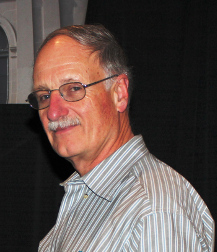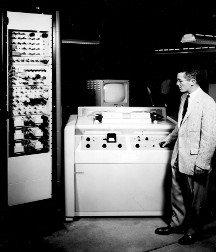Plan to Display Early VTR at NAB Show Stalls
ALEXANDRIA, VA.—Recently I reported about the Museum of Broadcast Technology (MBT) in Woonsocket, R.I. that specializes in displaying broadcasting “big iron”—early VTRs and cameras replete with scores of glowing vacuum tubes and supersized AC power cords. One of their biggest attractions is what may be the last surviving first-generation videotape recorder of its kind that still works. I learned the museum had high hopes of transporting this great granddad VTR to this year’s NAB Show, as 2016 marks the 60th anniversary of the VTR’s debut at that show (it was the National Association of Radio and Television Broadcasters, or NARTB, back then). At the time the unveiling was swathed in secrecy, with no one outside of Ampex and some top CBS engineering executives aware of what was about to take place at a CBS affiliates engineering meeting held concurrently with the Chicago show.

This Ampex Mark IV was the star of the 1956 NARTB Show. Here Phil Gundy, Ampex vice president, (far left) looks on as VTR design team members, (L-R) Shelby Henderson, Alex Maxey, Fred Pfost, Ray Dolby, Charlie Ginsburg and Charlie Anderson admire their creation. (PHOTO CRDIT: Fred Pfost)
The rollout of this new television time-shifting technology took the CBS group by storm and the enthusiasm was infectious, spreading to virtually everyone there at the Conrad Hilton Hotel which hosted the NARTB that year. (RCA had planned to make a big splash with some new color TV products, but their exhibit really didn’t get much foot traffic, as almost everyone was hovering over Ampex’s newest electronic wonder.)
SOME DISAPPOINTING NEWS
Let us now fast-forward 60 years and return to the story about sending this rare example of American technology and know-how to Las Vegas this month. I got word from one of the Museum’s co-founders, Paul Beck, a few days ago that, unfortunately, it’s not going to happen.

Paul Beck
“We received a number of donations, but there wasn’t enough to cover the anticipated expenses,” said Beck.
The professional video industry's #1 source for news, trends and product and tech information. Sign up below.
(As I mentioned in my original story, the MBT folks had initially been hoping for a funding grant to provide the estimated $25,000 to transport the heavy, bulky, and fragile machine to the NAB Show, but the grant didn’t materialize. I suggested in my story that readers who would like to see the VR-1000B make the trip to Las Vegas should donate as generously as they were able. Several readers did, but as observed by Beck, the amount raised wasn’t sufficient to “pay the freight.”)
BACKUP PLAN
While Beck and the MBT’s other co-founder, Tom Sprague, had been hopeful that their sexagenarian VTR’s ticket to Las Vegas would get punched, they are ready with a “backup of sorts” so visitors to their exhibit space will at least get some exposure to what video recording technology was once like.
“We will be bringing our two Ampex VR-3000s (backpack-sized 2-inch quadruplex machines) and we’ll be playing back some footage recorded on a portable machine from a schooner back in the mid-70s,” said Beck. “We’ll also be bringing along three operational RCA TKP-45 and a TKP-46 ‘minicams’ from the same period to show our visitors what portable color cameras looked like 40 years ago.” (Beck noted that the video on the demonstration tape they’ll be playing was captured with a TKP-45.)
“Also, there’ll be a high-def recording showing our VR-1000B in action,” said Beck. “This will be shown on a big screen to demonstrate the operation of the Ampex machine.”
While this will give show-goers a taste of what NARTB attendees witnessed 60 years ago, both Beck and Sprague admit that there’s nothing like the real thing and they’re disappointed that their machine won’t be making the trip to Vegas.
However, not all may be lost!
In my follow-up communication with Beck, he pointed out quite correctly that while the Ampex recorder did make its first appearance 60 years ago, what the NARTB crowd saw was basically an engineering prototype, the company’s “Mark IV.” (A slightly earlier version, the Mark III, remained behind at the Ampex Redwood City, Calif. plant where one of the design team members, Ray Dolby, hosted a press conference to show off the new technology to local newspaper and wire service reporters at the same time the curtain was being raised in Chicago.)
Anyway, Beck’s point was that the machine shown in Chicago 60 years ago was not the VTR that ultimately rolled off the Ampex production line. The VR-1000 didn’t happen until the following year.
(When I interviewed Ray Dolby back in 2006 in connection with my TV Technology story about the VTR’s 1956 launch, he remarked that with the successful showing of video recording and its acceptance at the Chicago NARTB, as soon as the show ended, the team’s next project was to figure out how to set up a production line for assembling the recorders in large quantities. [After all, some 75 or so sales orders had been written at the show and these had to be filled ASAP!] Dolby said that the team spent several months developing assembly line production techniques and it was not until 1957 that the first VR-1000s began to ship.)
SHOOTING FOR ANOTHER IMPORTANT ANNIVERSARY
“Next year’s NAB Show will mark 60 years since the VR-1000 was first shown,” said Beck. “Taking our machine to the 2017 NAB Show is probably more appropriate. And this gives us a year to raise funds and work out a detailed plan for getting the recorder to Las Vegas.
“We’re still very excited about the possibility of showing the machine and the extra 12 months will give us more time to plan the ‘hows’ of crating the machine and getting it out of our museum building and transported to Las Vegas safely,” he continued. “It will clearly have to go with some sort of ‘white glove’ service. The additional year will give us more time to work out the details.”

Tom Sprague
Beck and Sprague have estimated that it will require upwards of $25,000 to safely transport the Ampex recorder to and from Las Vegas. They remind those interested in making donations for the 2017 effort that the MBT is a registered 501(c)(3) non-profit organization and that donations made may be tax deductible. And just as in the original fund raiser, if the amount raised is insufficient to cover shipping and handling costs for the VR-1000, they will either apply donations received to cover other museum expenses or refund them depending on the donor’s wishes. If you’d like to help in this effort, please contact Tom Sprague at maindesk@wmbt.org.
Let’s see if we can’t make this plan a reality at next year’s NAB Show. Please donate as generously as you can!
WHERE IS THAT ‘OLDEST’ QUAD MACHINE?
I mentioned in my previous article that the first production VTR went to CBS, which had been in on the “surprise” NARTB unveiling. I also speculated that the whereabouts of that machine, if it still existed at all, was unknown. I decided to see if one of the real VTR history experts—Peter Hammar—might know what happened to serial number “0001.”

Pete Hammar
Hammar was the founder and curator of the Ampex Museum of Magnetic Recording and in this position was able to pull together a lot of the company’s history.
He stated that Ampex did deliver a few videotape recorders in 1956. However, these were the model VRX-1000, a sort of “go-between” that bridged the gap between the Mark IV demonstrated in Chicago and the VR-1000 that premiered in 1957. According to Hammar, 16 of these intermediate machines were manufactured.
“The VRX-1000 was the pre-production model for the VR-1000,” said Hammar. “These were hand-wired, and the first three machines were kept at the factory to serve as test ‘mules.’”
Hammar noted that some very necessary modifications to the Mark IV were made in the VRX-1000s, including a reduction in the depth of the machine. “The overall form factor was the same, but at 38-inches deep, the Mark IV couldn’t fit through most doorways.” he said, explaining that early on, the team had planned to include all of the support electronics in the base of the VTR, hence the 38-inch depth. He added that the first three “mule” machines had been disposed of long ago.
So what about the next VRX-1000 produced—serial number four?

Ampex VTR development team leader Charlie Ginburg poses with one of the 16 VXR-1000 machines assembled. (PHOTO CRDIT: Fred Pfost)
Hammar said it went to CBS’s Hollywood “Television City” facility where it was pressed into service to time-shift New York programming three hours for airing on the West Coast.
I’d remarked in my March story that whereabouts of this CBS machine was unknown—probably long since MIA—and asked Hammar if he could shed a little light on what became of this very early and historic VTR.
“Yes, I can,” he said. “This VRX-1000—serial number four—was in the Ampex Museum until the early 1990s. Then it went into storage in a San Carlos [Calif.] warehouse. Later it was sent to the Ampex facility in Colorado Springs, and finally went to Stanford University where it’s still in storage.”
Mystery solved!
And while it’s good to know that this important relic is still around, Hammar is unsure as to whether the machine is complete any more or could even be displayed, so it looks as if the Museum of Broadcast Technology still has the claim to the earliest complete and operable Ampex quadruplex VTR.
I’ll see you at the Museum of Broadcast Technology’s booth!
